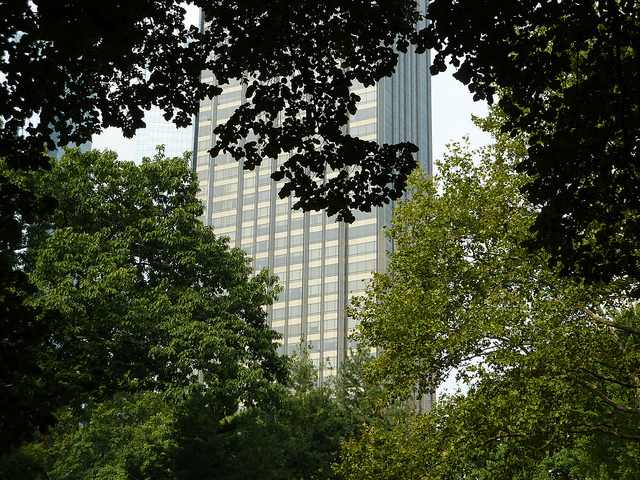
The city’s skyline is being transformed. Is that good or bad—and for whom? (Flickr / Manel)
This is the fourth post in The Brooklyn Quarterly‘s “Speaking of…” column, in which New Yorkers weigh in on the most pressing hypothetical questions of our time. Read the previous installment here.
“Vines strangling their own kin in the everlasting wrestle for sunlight . . . [A] choir of seedlings arching their necks out of rotted tree stumps, sucking life out of death. This forest eats itself and lives forever.”
Tait Mandler, a graduate student in Design and Urban Ecologies at Parsons, has directed me to these lines from Barbara Kingsolver’s 1998 novel The Poisonwood Bible.
“I don’t mean to depoliticize gentrification through analogy,” Mandler cautions, but “sometimes, this is how I think about the city.”
The City That Never Sleeps. The Capital of the World. The Center of the Universe. New York is an ever-changing hyperbole. Frank Sinatra sang, “If I can make it there, I’ll make it anywhere”—half a prayer, half a shout of defiance.
Because not everyone, or everything, makes it here.
The Hippodrome (1905–1939), the Singer Building (1908–1968), the much-mourned original Penn Station (1910–1963)—all eaten by the mother that birthed them. In the last decade, some areas of the city have altered so dramatically that the skyline has become essentially unrecognizable.
Nowhere is this change more evident than along “Billionaires’ Row,” known to non-billionaires as simply West 57th Street.
Peter works security (and serves as ad hoc doorman) at a commercial building on 57th between Sixth and Seventh Avenues, putting him at the epicenter of the midtown boom.
“I hope the sidewalk doesn’t cave in. That’s my serious main concern right now.” We look across the street at 111, where a curtain billboard has been hoisted onto the landmarked Steinway Hall proclaiming its glorious, SHoP-designed future inhabitant. “I mean, I’m no engineer, but…”
And while such worries could seem farfetched, Peter has seen high-stakes structural failures before, having witnessed the crane that toppled at One57 during Hurricane Sandy, causing police barricades that closed down an entire block of offices, apartments, and hotel rooms.
“It’s a bit unnerving when you’re looking all the way up and this thing is swinging back and forth…so I’m concerned,” he says, and laughs tightly. When the unexpected happens—1,000 feet over your head—it’s hard to shake that sense of unease.
However, for the white-haired Stella, a Russian immigrant who’s lived in New York City twenty-four years, this race skyward is exciting. She has been watching the changes from her apartment on Roosevelt Island, but today she is closer to the action, sitting in front of the Naumburg Bandshell enjoying the late afternoon air in Central Park.
“I like them, but my English is…” and she hesitates self-consciously, unsure how to best convey her assessment. The glass-covered towers represent to Stella a certain “New York style of architecture” that’s distinct from her memories of Moscow and St. Petersburg.
“You know that building on 57th?” she asks, referring to One57 and its multicolored glass panes. “It is blue and white and light green, and they are not flat, the sides. I like it. It’s fun—for the city.”
“You agree with my opinion?”
I demure.
But retiree Pierre, setting up in Sheep Meadow to photograph late-season migratory birds, does not.
“Just imagine the whole skyline and the whole city.” He fiddles with his tripod, irritated that I’m distracting him from his preferred pastime. “They’re building higher and higher and higher, and one day you’ll just be able to reach up and grab the cheese off the moon.”
He adds, “That’s not progress.” Dusk will be here soon, and Pierre is joined by a friend. “We want to be able to see the sunset going down.”
And in a way, the sunset is being stolen from people like Pierre, who moved from upstate New York fifty years ago for job opportunities—in other words, from people without $50 million to spend on a shell apartment.
Indeed, to some, it’s not just the sunset that ordinary New Yorkers are being cheated out of.
“The building of uber-expensive luxury high-rises is not a given or even a logical activity,” Mandler, the grad student, tells me. With it, the city loses the opportunity for “widespread affordable housing for every income bracket,” which Mayor de Blasio and numerous experts agree is about as urgent now as it’s ever been.
“For me,” Mandler continues, smarter municipal development means “fostering greater income equality, creativity, and diversity.”
And for those of us who aren’t eyeing condos at 432 Park Avenue or 217 West 57th, what sort of growth is New York nurturing? The forest might survive, but who gets to live in it?
.
 David Speer is a writer and performer based in New York City.
David Speer is a writer and performer based in New York City.
